In brief:
- Demand for help desk outsourcing is soaring as organizations continue to combat macroeconomic challenges and plan for prudent spending this year.
- Clients are showing a greater preference for a service provider within the same geographical region, even if a lower cost can be realized with providers located far off.
- Service desk operations are gaining importance as a key avenue for driving better employee experience.
- Uptick in adoption of swarming or single-tier support to solve complex service cases or major incidents.
- Automation and AI is key for improving service experience, but lack of skilled talent remains a challenge for adoption.
Help desk today is a critical part of IT operations, fueled by growing digitalization, hybrid working, and the need for 24/7 support for globally distributed operations. At the same time, it has also grown increasingly difficult and expensive to provide help desk as an in-house operation. The severe IT labor shortage has stretched IT departments thin, with Help Desk Tier 1 agent ranking among the hottest tech jobs this year, based on Robert Half’s 2024 Salary Guide.
Further compounding the problem, help desks in the U.S. are seeing high turnover rates of 42%. The average North American help desk agent stays less than 2.5 years and costs $12,000 to replace, according to Help Desk Institute.
Not surprisingly then, help desk is one of the most outsourced IT functions today. Below are some of the emerging service desk trends to watch in 2024, and the best solution for overcoming the IT talent shortage and high cost of labor to gain a high-performing, cost-effective help desk.
1. Help desk outsourcing is on a growth streak
Help desk outsourcing has grown in leaps and bounds in the last couple of years, more than doubling from 2021 levels. According to the 2023 IT Outsourcing Statistics Report by Computer Economics, 50% of the organizations are already outsourcing their help desk function entirely or in part. The report found it to be one of the most outsourced functions, along with desktop support and disaster recovery services.
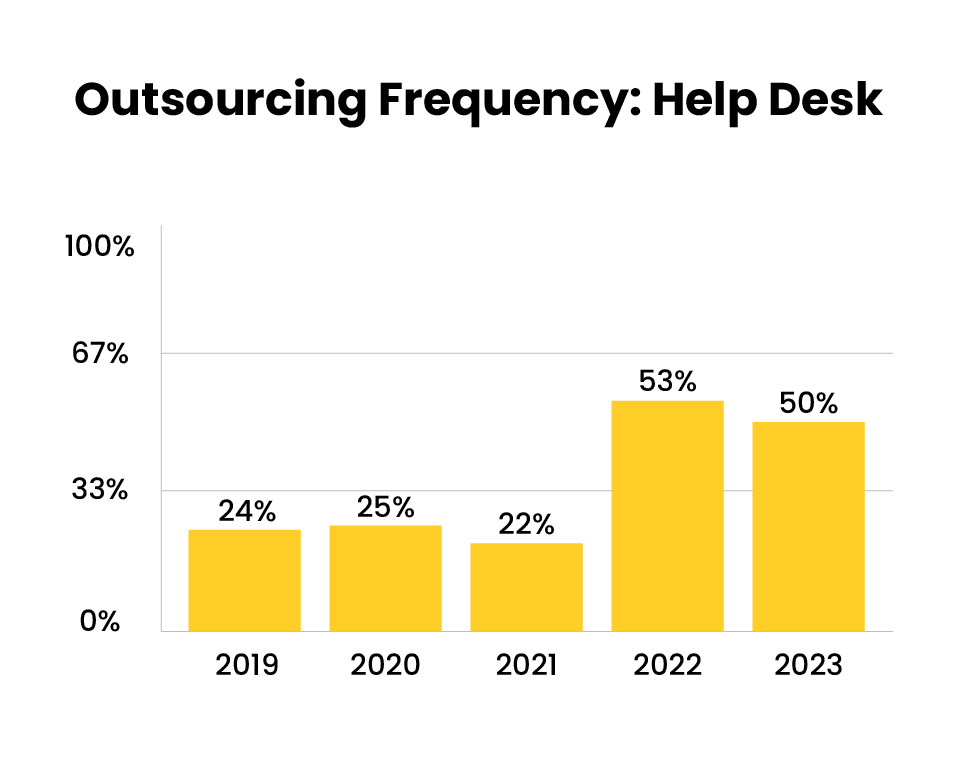
At the same time, organizations that choose to outsource their help desk typically do so at a larger percentage compared to other IT functions. The average organization is outsourcing 55% of their help desk and desktop support, occupying the top spot by outsourcing level.
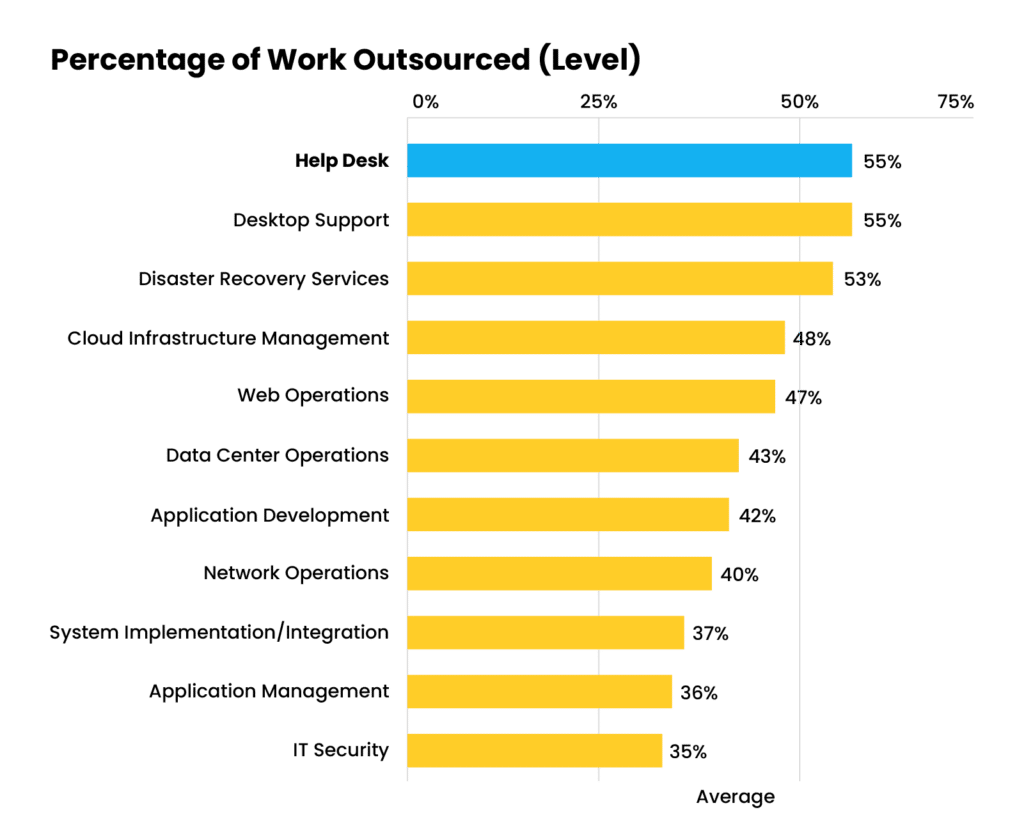
Help desk outsourcing is projected to continue this growth trajectory, with 91% of organizations expecting to either increase (36%) or maintain (56%) the level of work being outsourced, and only 9% of organizations expecting to decrease it.
Further in the article we will touch on some of the key reasons and drivers for this increase in outsourcing.
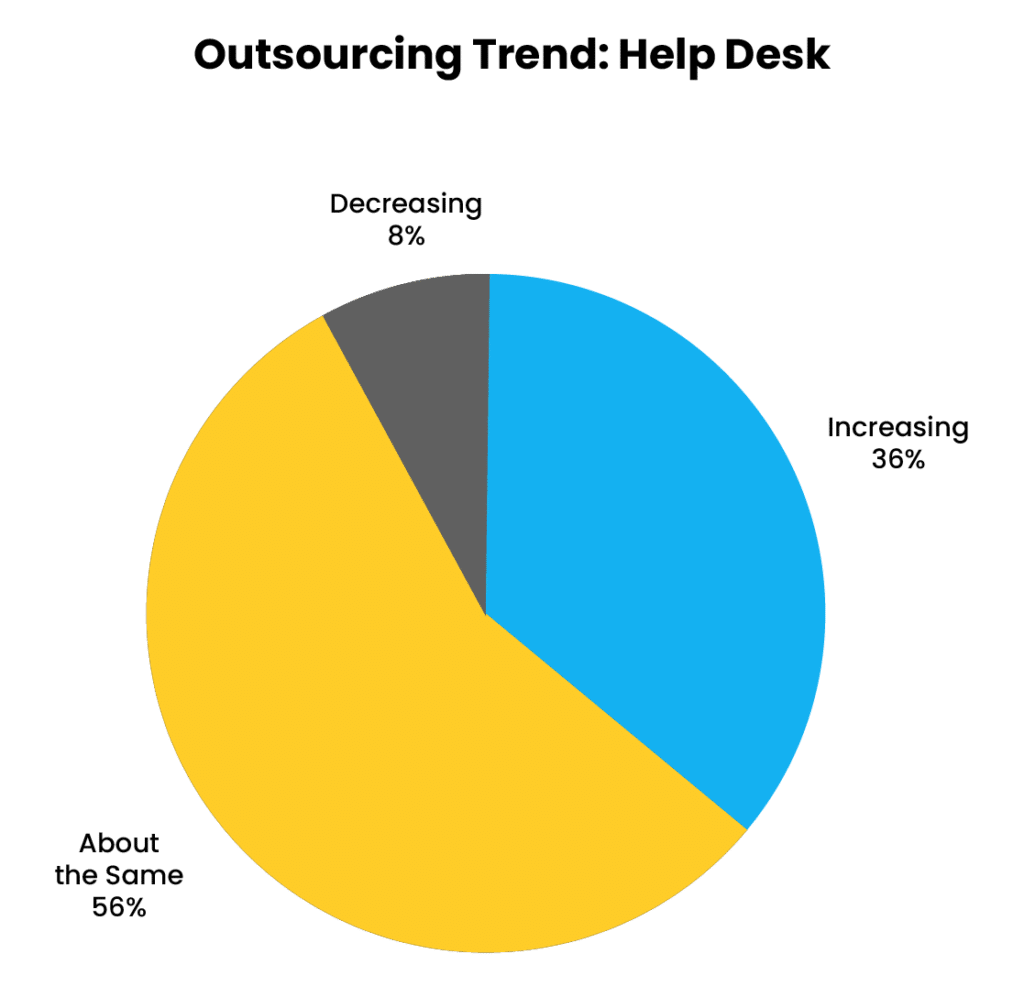
2. Help desk outsourcing is a proven method to reduce costs
There can be many motivations for outsourcing an IT function, but reducing costs is often one of the goals. Functions ripe for outsourcing are frequently those that are subject to economies of scale or can be handled in nearshore or offshore locations to take advantage of lower labor costs.
Computer Economics defines a “successful cost experience” as one in which outsourcing a function costs the same as or less than performing the function in-house.
Given the macroeconomic pressures and fears of recession through most of 2023, revenue growth and a continued emphasis on cost optimization are the top concerns for enterprises in 2024, the Everest Group 2024 Key Issues Study found. In this scenario, it is heartening that help desk outsourcing has the most positive cost-success rate compared to any other IT function. About 91% of the IT organizations that outsource this function say their costs are either lower (63%) or the same (28%) than when performing the function in-house.
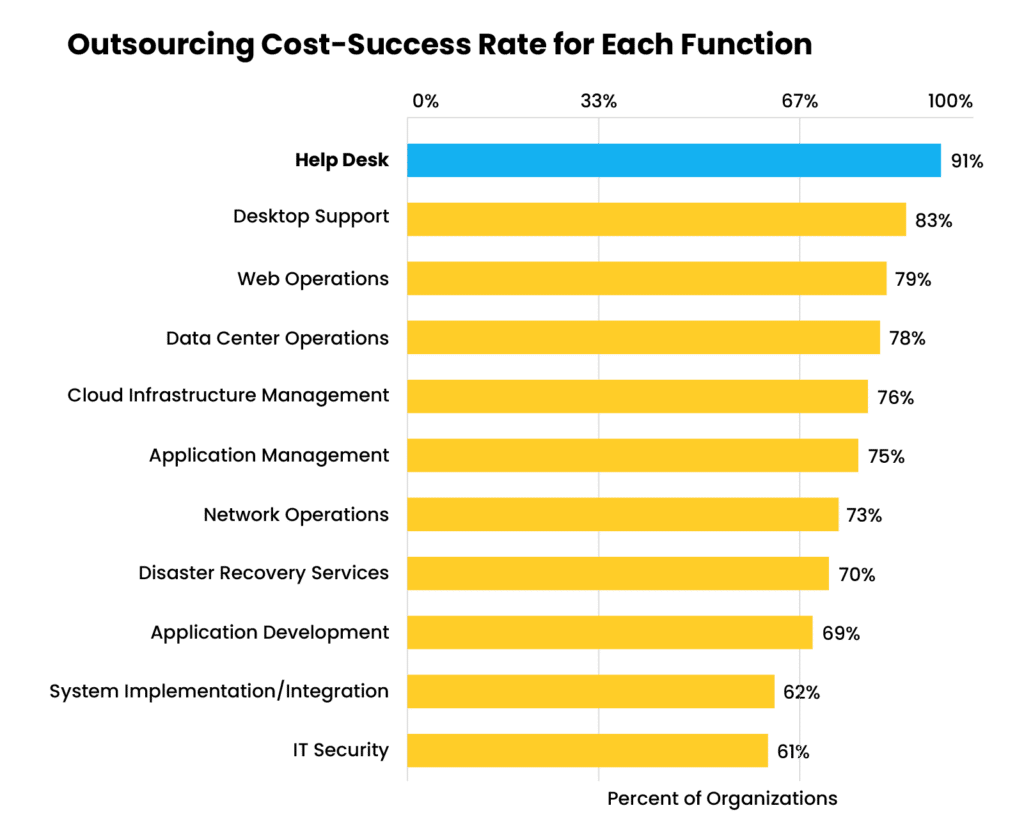
Outsourcing to lower cost regions, including Latin and Central America and Asia, reduces not only the labor cost but also the indirect cost of in-house recruiting, training, and retention. Several outsourcing providers also offer flexible pricing models, allowing companies to scale services based on demand.
Best-in-class IT Managed Services partners also bundle the cost of the technology as part of the service, providing the client access to best-in-class Service Management, Contact Center, and automation tools and services at a fraction of the price it would cost them to acquire those technologies on their own.
Based on our experience, clients in North America are on average saving 30% to 50% of their help desk labor costs by nearshoring with Auxis. When including the cost of technology and other frequently “hidden” costs, the business case becomes even higher.
3. It’s not just about the savings. It’s about improving the service.
The benefits of help desk outsourcing extend beyond cost savings. Among IT organizations that outsource the help desk function, 78% consider their service experience to be either “better” (30%) or the “same” (47%) than when they used to perform the service in-house, while 23% consider it to be “worse.”
This service-success rate of 78% is considered a low rating relative to other functions in the study such as Cloud Infrastructure Management (92%) or Network Operations (88%).
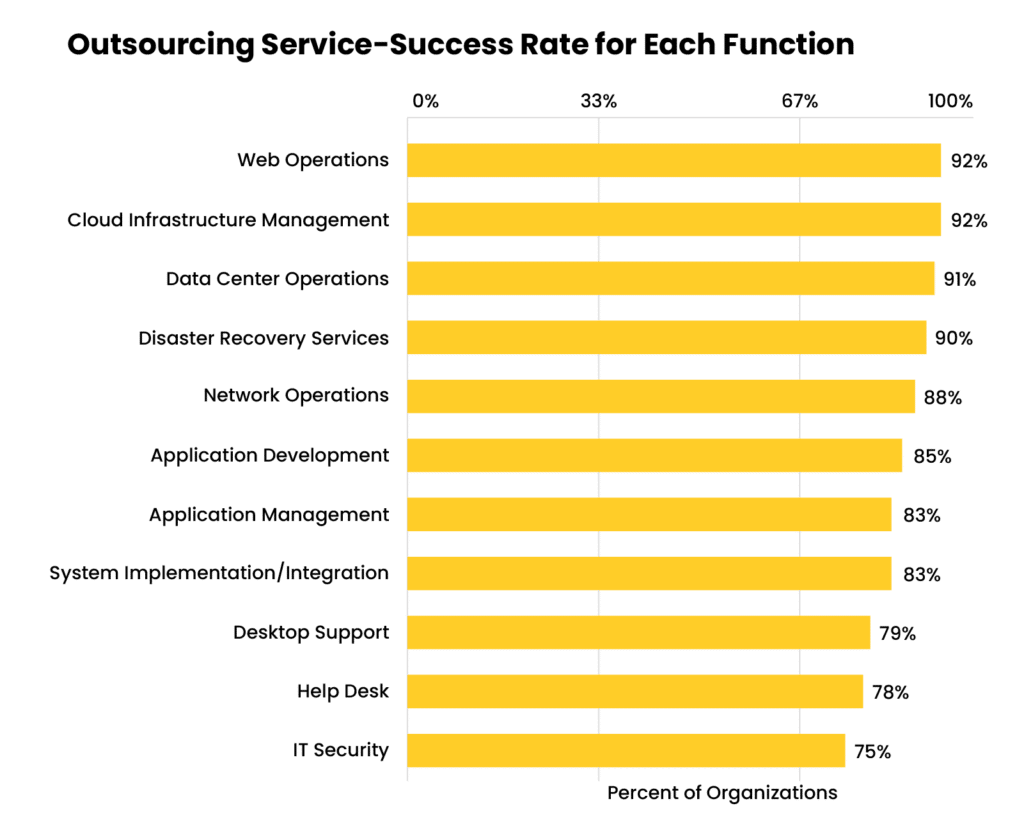
The key takeaway here is that even if cost optimization may be a “guaranteed” result when outsourcing, that is not always the case with service delivery improvement. The help desk is the face of the IT Department for the entire organization, and IT executives need to carefully vet and select a provider that will truly care about the customer experience.
Many times, we see organizations making decisions based on the “lowest cost per ticket” and not thoroughly analyzing the capabilities of their selected partner to document, migrate, and continuously improve their processes with strong, proven methodologies and tools.
Based on our discussions with CIOs interested in Auxis’ help desk services over the last few years, we are seeing a notable shift in why they are looking to outsource. Along with savings, there is a growing preference and demand for:
- Improved, consistent end-user experience
- Expanded coverage hours
- Access to best-in-class automation, performance management, and reporting tools
- Simplified talent management so you don’t have to worry about recruiting, onboarding, training, and retention
- Reallocation of internal IT staff towards higher-value, revenue-generating activities
To learn more about outsourcing your help desk for benefits beyond cost savings and service quality, check out our blog 6 Outstanding Benefits to Outsourcing Your Help Desk.
4. XLAs over SLAs: Employee experience is top priority for help desk clients
Today, many organizations are recognizing the importance of service desk for providing a happy employee experience. With the latter proven to result in higher productivity and engagement levels as well lower attrition and employee turnover, about 73% of IT departments now link their KPIs to employee satisfaction, the SysAid 2023 State of Service Management Report found.
The shift in priorities towards employee experience is further evident in the growing preference for Experience Level Agreements (XLAs) over traditional Service-Level Agreements (SLAs). SLAs have traditionally focused on metrics such as response times, resolution times, and uptime.
However, there is a growing realization that end-user experience can be unsatisfactory even with rapid response times. The Global IT Experience Benchmark: H1/2023 found that each time a ticket is reassigned, end-user happiness decreases by nearly eight points, and users lose an average of 1 hour and 42 minutes of work time per reassignment!
When working with an outsourcing partner, clients are now taking a more outcome-oriented approach, hence shifting towards a more user-centric and strategic partnership with their service provider.
2025 Auxis Help Desk Report: A Step-by-Step Guide to Successfully Outsourcing your Service Desk

5. Nearshoring: An increasing preference among service desk outsourcers
The Computer Economics report found that clients are more likely to choose a service provider within their same geographical region due to the reduced operational challenges, easier management of data residency issues, and compatibility of language, culture, and time zone. In fact, they are showing greater preference for a service provider within the same geographical region, even if a lower cost can be realized with providers located far away.
The bottom-of-the-barrel pricing and overnight shifts needed to align with U.S. business hours in offshore locations like India and the Philippines leave many providers struggling to attract “A team” resources capable of resolving urgent help desk issues quickly. Asia’s notoriously high turnover is also at its worst during overnight shifts, impacting consistency and performance.
By comparison, Latin America’s shared or similar time zones and less-saturated labor markets foster significantly less turnover, fewer delays, and effective, real-time support from top-tier talent.
The World Economic Forum-endorsed INSEAD 2023 Global Talent Competitiveness Index underscores India and Latin America’s widening talent gap. India’s talent competitiveness has decreased every year since 2020 on the Competitiveness Index as difficulty attracting and retaining talent in a saturated labor market leads to an increased skills mismatch for employers.
India ranks 103rd globally on the 2023 report, while top nearshore markets like Costa Rica, Colombia, and Mexico score significantly higher – coming in at 47, 72, and 74, respectively.
This chart from the INSEAD report shows how Latin America’s talent competitiveness outpaces Central and Southern Asia in every area:
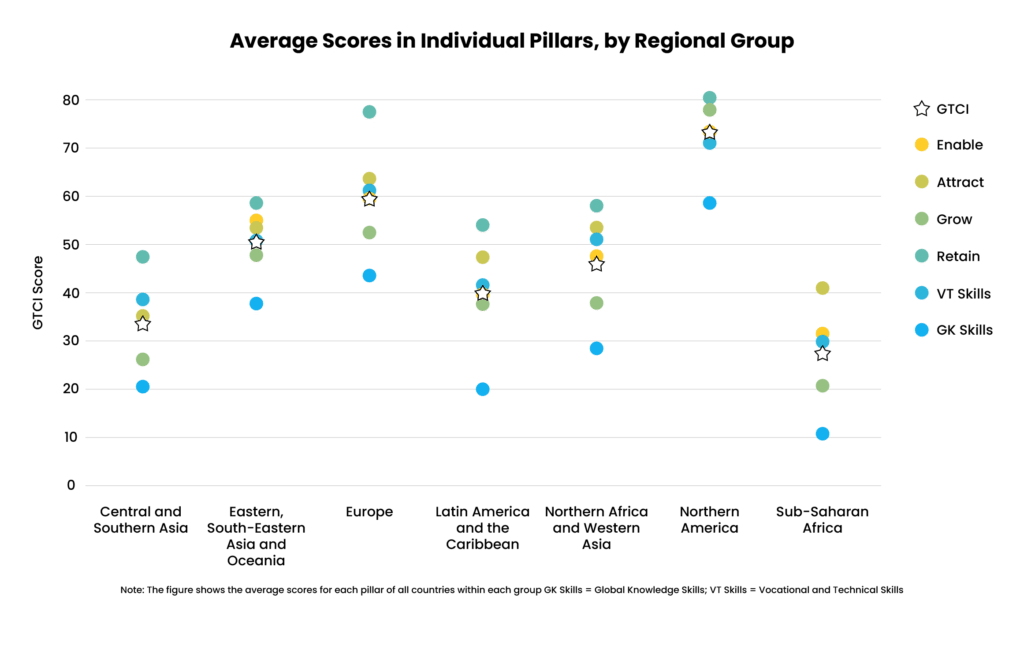
Not surprisingly, the number of foreign companies hiring from Latin America has increased by 156%, the most for any geography, a report by global hiring firm Deel found. Nearshore tech hubs like Colombia and Costa Rica offer North American enterprises the best combination of talent, cost, service quality, geographic proximity, and affinity to the U.S.
Colombia ranks #1 for skilled talent availability in LATAM on IMD’s 2023 World Talent Report, offering potential for scalable operations in six metropolitan areas with 1 million+ inhabitants and 15 with 500,000+. It is also the most financially attractive of LATAM’s top markets, according to the 2023 Kearney Global Services Location Index.
Ranked among the top three countries in Latin America on the 2023 Global Talent Competitiveness Index, and #1 for attracting talent, Costa Rica combines one of the region’s highest English proficiencies with the most mature shared services market in LATAM.
With the many advantages offered by nearshoring help desk, it is today a compelling alternative for companies seeking cost-effective, high-quality support solutions with minimized risks and enhanced collaboration opportunities.
6. Increasing adoption of a swarming support model for faster, better support
Efficient ticket routing and resolution is key to maintaining high levels of employee satisfaction. With that in view, many help desk providers are adopting swarming to solve complex service cases or major incidents.
Swarming, where cross-functional teams collaborate to resolve issues in real time – as opposed to the traditional tiered support structure of well-defined escalation paths and designated issue hand-offs – has provided better results for companies who have moved to this single-tier model: more satisfied employees, lesser turnover of skilled agents, greater customer satisfaction and loyalty leading to higher renewal rates and gross margins.
Net Promoter Scores of providers using swarming and single-tier support were 12.4 points higher than those not using a swarming model, the Technology & Services Industry Association (TSIA) found. Those using a swarming process also saw 5.4% higher contract renewal rates.
7. Automation and AI are key for improving service experience
Providers are increasingly recognizing the need to adopt automation to help alleviate stretched IT help desks and shift them from “break fix” mode to being proactive. 73% of organizations today have artificial intelligence (AI) capabilities within their ITSM tools, a 2023 ITSM.tools survey found.
Chatbots built on script-based automation have taken over many routine service desk tasks such as answering frequently asked questions, guiding users through troubleshooting processes, and providing status updates on support tickets. They can manage tasks like password resets and software updates without manual intervention.
Artificial intelligence (AI) is also making it possible for many providers to offer 24/7 support through self-service options such as chatbots and knowledge bases, which act as Level 0 support and reduce the need for raising tickets and speed up problem resolution.
By leveraging machine learning and data analysis, AI is also forecasting potential IT infrastructure issues before they disrupt operations. This proactive approach allows IT professionals to address problems efficiently, preventing costly downtime and service interruptions.
Still, barriers exist for organizations to be able to leverage intelligent automation successfully. The ITSM tools survey found that the biggest challenge for adopting AI in ITSM is the “lack of skilled people internally.” Some of the other major challenges cited for successful AI adoption are data security, additional cost, and inaccuracy or inconsistency of responses.
The rise of Generative AI (GenAI) presents a new frontier for help desk services. This advanced form of AI holds the potential to transform customer support operations, reshaping the industry landscape in the process, with some large organizations already betting on the technology to replace the traditional service desk.
Outsourcing your help desk for long-term success
Help desk outsourcing has proven to be a successful strategy over the years for delivering quality IT support without breaking the bank. Hence, it is no longer a question of whether you should outsource the function or not, but how you choose to do so and the service desk professionals you partner with.
Selecting a reliable help desk nearshoring partner is key to elevating your help desk to a modern, service-centric operation. Along with cost effectiveness, the right partner also provides technical expertise, 24x7x365 support, and the latest technology innovations to improve focus on proactive, strategic, and higher quality work and enables you to rapidly scale up or down as required.
Want to learn more about how help desk services and nearshore outsourcing can support your business needs? Schedule a consultation with our help desk leaders today! Or visit our resource center to learn more help desk trends, strategies, and success stories.



